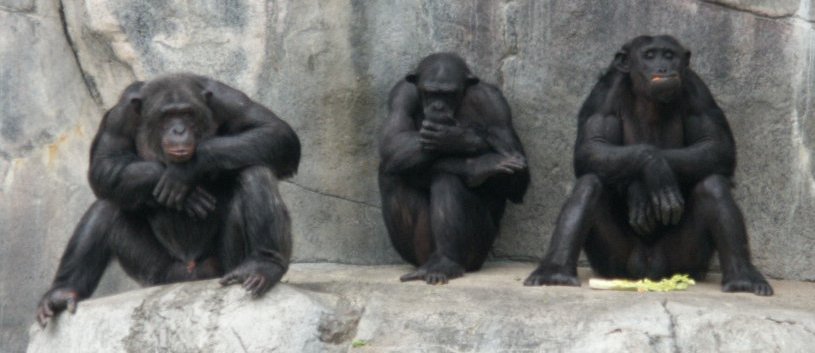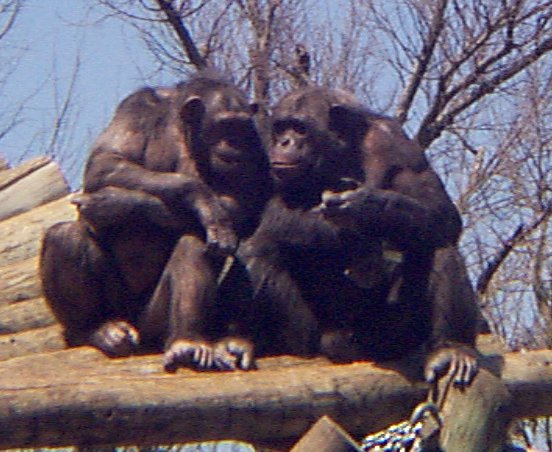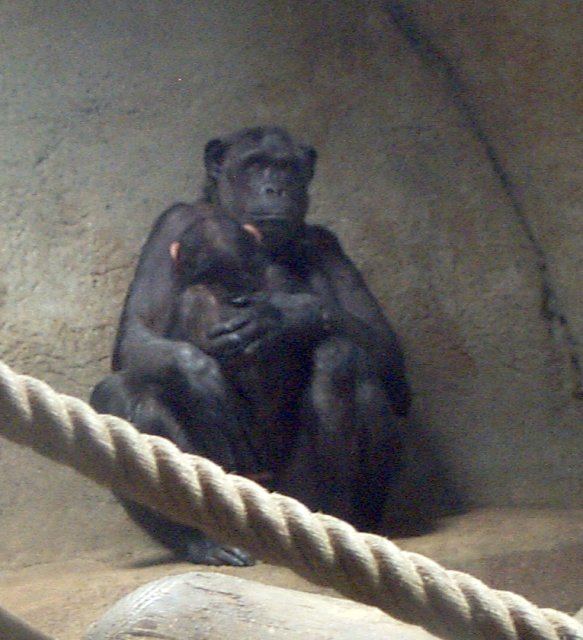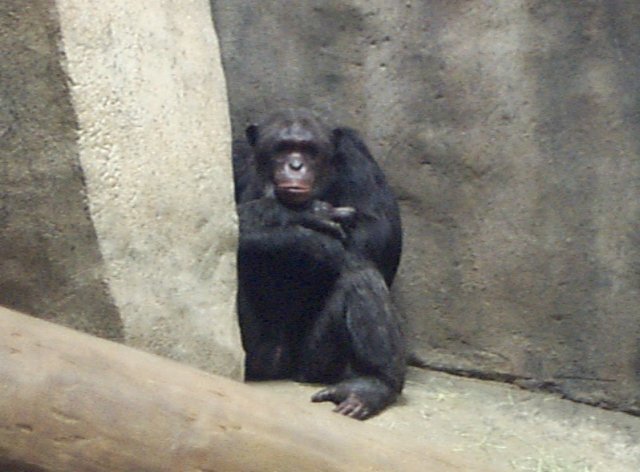
Scientific Name: Pan troglodytes
Physical Description:
Chimpanzees are born at a weight of approximately 4 pounds and but
as adults reach a weight that is usually between 95 and 150 pounds (Sheila
Clark), but in some case they can exceed 200 pounds. Their
bodies are
covered with black and brown hair, but their faces are hairless (big
zoo). They can have grey especially on the under chin area of
older males (which can live to be 35 - 45 years in the wild and as
long as fifty in captivity) (SCZ). In addition they have
large external ears (big zoo). Chimpanzees arms are unusually long; they are 50 % longer than their body (big zoo).
Chimpanzees also have opposable thumbs.
In addition there are differences among the three subspecies of common chimpanzee:
The Pan Troglodytes Schweinfyrthii (or Eastern Chimpanzee) has longer hair than the others and has bronze or copper facial skin. (Primates)
The Pan Troglodytes Troglodytes (or Central Chimpanzee) has black facial skin. (Primates)
The Pan Troglodytes Versus (or Western Chimpanzee) has pinkish facial skin that tends to darken as the chimp gets older. (Primates)
Social Organization::
Chimpanzees are very social animals and usually live in groups of
between 20 and 80 animals. Each group tends to have a
dominate male and to a lesser degree a dominate female, but it is
common for this hierarchy to change. With in the groups
subunits are devised for hunting and gathering. Young are
weaned at approximately five years of age (big zoo), and are often
cared for with the help of other female relatives. Perhaps,
because these groups are large and the leadership is fluid, a
considerable amount of time is spent reinforcing bonds by grooming
and in the case of some subspecies with sexual acts. They use
facial expressions, vocalization and gestures to communicate.
Chimpanzees are also highly hostile to other groups.
Special Adaptations:
The
Chimpanzee is known for it's use of tools which is most commonly
seen being demonstrated as the chimpanzee uses a stick to extract
termites from their mounds; they do however use tools in other
manner as well. This is not an instinctive behavior and must
be taught to their young. Chimpanzees build nest of tree
limbs, leaves and brush to sleep in at night. Although, some
choose not to build and steal their nest from another chimpanzee.

Reproductive Behavior:
Females come into estrus for the first time at
age 8 or 9 but are not the older males are not usually attracted to
them until they are 10 or 11 (probably because they are not fertile
until this time). Once a female gives birth she will usually
not do so again for about 5 years, unless her infant does not
live . The males are apparently more attracted to some females in estrus
than they are to others. All of the adult males may pursue a
female and sometimes even with adolescents and juveniles following
along. However, the dominant male may try to keep her to
himself and try to keep others away from her. In
addition lesser males sometimes persuade a female to accompany them
to an outlaying area of their territory where they try to get her
to stay until the end of her estrus. In this way even the
low ranking males are capable of fathering young (Goodall).


Personal Observations:
When I observed the Chimps at the Fort Worth Zoo, they were originally not interested in the audience and seemed somewhat lethargic. For the most part they were just sitting around. However, I returned to find them in different spirits. They seemed to be attempting to entertain the audience by jumping and swinging around. Anything that people particularly enjoyed the chimps seemed to repeat. I guess you just have to catch them at the right time of day.
Page Author:
Eric Briscoe
Briscoe007@hotmail.com
Sources and Links:
http://www.janegoodall.org/chimps/social.html
http://www.thebigzoo.com/Animals/Chimpanzee.asp
http://www.scz.org/animals/c/chimp.html
http://www.primates.com/chimps/chimpanzee-info.html